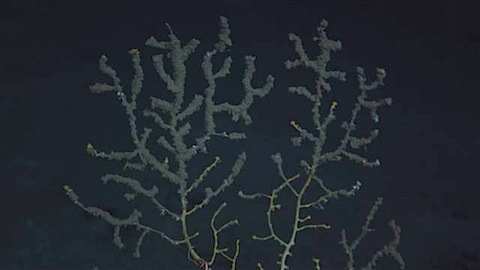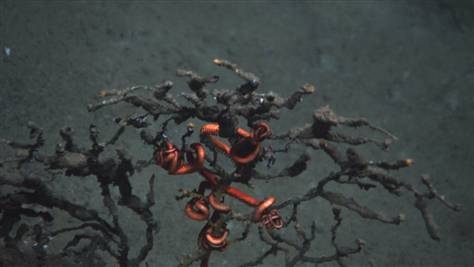Dead, dying coral found near BP spill called 'smoking gun'
Opednews
msnbc.com staff and news service reports msnbc.com staff and news service reports
updated 11/5/2010 5:07:41 PM ET 2010-11-05T21:07:41
'We have never seen anything like this,' chief researcher says

Lophelia II 2010, NOAA OER and BOEMRE
A close up of one of the impacted corals. A small amount of apparently living tissue on the tips of some branches is orange. Most of the skeleton is bare or covered by brown flocculent material.
Scientists returning from an expedition off the Gulf Coast said Friday they found dead and dying deepwater coral near the BP oil spill site that was covered in a brown substance.
"The compelling evidence that we collected constitutes a smoking gun" that the substance is tied to the BP spill, the chief researcher on the cruise, Penn State biologist Charles Fisher, said in a statement Friday.
"We have never seen anything like this," he added. "The visual data for recent and ongoing death are crystal clear and consistent over at least 30 colonies; the site is close to the Deepwater Horizon; the research site is at the right depth and direction to have been impacted by a deep-water plume, based on NOAA models and empirical data; and the impact was detected only a few months after the spill was contained."
"These kinds of coral are normally beautiful, brightly colored," Fisher said. "What you saw was a field of brown corals with exposed skeleton — white, brittle stars tightly wound around the skeleton, not waving their arms like they usually do."
Fisher described the soft and hard coral they found seven miles southwest of the well as an underwater graveyard. He said oil probably passed over the coral and killed it.
The coral has "been dying for months," he said. "What we are looking at is a combination of dead gooey tissues and sediment. Gunk is a good word for what it is."
The researchers found the evidence at a site 4,600 feet deep.
"Ninety percent of 40 large corals were heavily affected and showed dead and dying parts and discoloration," the National Oceanic and Atmospheric Administration said in a statement. NOAA sponsored the cruise. "Another site 400 meters (1,200 feet) away had a colony of stony coral similarly affected and partially covered with a similar brown substance."

Lophelia II 2010, NOAA OER and BOEMRE
One of the impacted corals with attached brittle starfish. Although the orange tips on some
branches of the coral is the color of living tissue, it is unlikely that any living tissue remains on this animal.
NOAA Chief Jane Lubchenco said she was concerned about "impacts to marine life in places in the Gulf that are not easily seen."
For the government, the findings were a departure from earlier statements. Until now, federal teams have painted relatively rosy pictures about the spill's effect on the sea and its ecosystem, saying they had not found any damage on the ocean floor.
In early August, a federal report said that nearly 70 percent of the 170 million gallons of oil that gushed from the well into the sea had dissolved naturally, or was burned, skimmed, dispersed or captured, with almost nothing left to see — at least on top of the water. The report was blasted by scientists.
Still, NOAA stopped short of attributing the substance to oil from the spill, or to the chemical dispersants used to break up some of the oil.
"Further testing will also determine if the substance is oil, and if so, whether it is consistent with the release from the Deepwater Horizon oil spill," NOAA said.
The researchers from government and academia worked off a ship that had a remotely operated vehicle that took samples and photographs. The ship returned to port on Thursday after three weeks at sea.
Eric Cordes, a Temple University marine scientist on the expedition, said his colleagues have identified about 25 other sites in the vicinity of the well where similar damage may have occurred. An expedition is planned for next month to explore those sites.
When coral is threatened, its first reaction is to release large amounts of mucus, "and anything drifting by in the water column would get bound up in this mucus," Cordes said. "And that is what this (brown) substance would be: A variety of things bound up in the mucus."
Ocean Conservancy, a group that had worked on the Exxon Valdez oil spill restoration efforts, urged the Obama administration to constantly and consistently monitor the subsea areas around the BP site.
"The deep sea coral damage that has been identified by federal scientists is another reminder that the governments must vigorously explore all possible injury from this oil disaster and seek appropriate compensation in support of Gulf restoration," Stan Senner, Ocean Conservancy’s director of conservation science, said in a statement.
"The Gulf of Mexico is a special place, providing the nation with food, jobs, and a unique way of life," he added. "Measuring its full impact will take years, and fully restoring the Gulf will take decades."
A Gulf Coast Ecosystem Restoration Task Force ordered by President Barack Obama last month will have its first public meeting on Monday. Made up of federal and state agencies, it is headed by Lisa Jackson, head of the Environmental Protection Agency.
Coral is essential to the Gulf because it provides a habitat for fish and other organisms such as snails and crabs, making any large-scale death of coral a problem for many species. It might need years, or even decades, to grow back.
"It's cold on the bottom, and things don't grow as quickly," said Paul Montagna, a marine scientist at the Harte Research Institute for Gulf of Mexico Studies at Texas A&M University in Corpus Christi. He was not on the expedition.
Montagna said the affected area is so large, and scientists' ability to explore it with underwater robots so limited that "we'll never be able to see everything that happened down there."
The Associated Press contributed to this report.